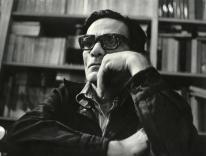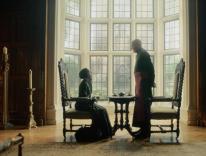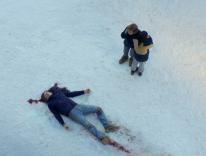Farce is the first cousin of melodrama. Both employ the same devices: people entering rooms at precisely the wrong moment and seeing what they should not see; the misreading of (mostly romantic) motives and intentions; marriage perceived as a trap with metal teeth; adultery perceived as an escape from that trap even if the escape means gnawing off one’s own foot; innocent bystanders whose only function is the bedevilment of the main characters. The paradigmatic prop in farce is the banana peel; in melodrama it’s a bullet. Both lay their victims low, though in farce the victims may arise before the final curtain falls.
Ira Sachs’s film Married Life is a farce disguised as a melodrama. The trappings of melodrama are certainly in evidence: a man plans to murder his wife; poison is switched from one bottle to another; a handsome bachelor wants to extricate a lovely heroine from her entanglement with the murder-minded married man; a car races against time to save a poisoned woman. But throughout this movie suspense is undercut by humor and irony. Nothing here is intended to make our hearts race, and if we find ourselves on the edge of our seats, it is only to hear better the muffled malicious laughter of the filmmakers that informs the civilized dialogue and the pizzicato mockery of Dickon Hinchliffe’s score. The story—set in 1949—seems constantly to be headed toward bloodshed, but the script (by Sachs and Oren Moverman from a novel by John Bingham) has nothing but a banana peel lying in wait for a man with a vision of perfect love. This is farce, slowed down, softened, and polished, but farce nonetheless.
The man with a vision is Harry Allen (Chris Cooper), himself something of a trap for an unwary audience. There is, initially, a complexity to his character that doesn’t suggest farce. Harry, a successful businessman, is a dangerously idealistic romantic. He’s married to Pat (Patricia Clarkson), who has affection for her husband but believes that a good marriage is grounded strictly in sex and an easy lifestyle. But Harry, determined to be truly loved, falls for a beautiful, pure-hearted war widow, Kay (Rachel McAdams). He considers divorce but decides Pat would be so miserable as a middle-aged divorcée that she would be better off dead. So he plots her murder.
With its compound of idealism and murderousness, solipsism and neediness, Harry’s character would seem to cry out for a Dostoyevsky or, at least, an Updike. But Ira Sachs seems to have bitten off more psychology than he can, or will, chew. The hero’s character doesn’t unfold or ramify; it merely exists to be jumped through certain melodramatic hoops in an act that quickly becomes comic. Sachs knows what he’s doing, and he isn’t out to thrill or grip us. He only wants us to chuckle.
So I wish that Married Life were a bit neater, because a cynical little movie must be tidily constructed. The script (perhaps emulating the source novel, which I haven’t read) introduces Harry’s best friend, Richard (Pierce Brosnan), as both the hero’s nemesis and the narrator of the entire story. It’s the latter function that doesn’t work here, for we are given to understand that Richard knows every murderous and adulterous twist in the plot because he has heard the whole story from Harry himself in the wake of events. Given Harry’s secretive, obsessive nature, this doesn’t make any psychological sense. Nor is it remotely believable that Richard, who is an opportunistic rake but eminently sane and basically decent, would remain on such good terms with a man who plotted murder. Still, because Pierce Brosnan has aged so magnificently as a physique and as a talent, his Richard becomes the most compelling presence on screen. We root for him to take Kay away from Harry, as if the latter were simply a monster to be foiled. But this couldn’t have been Sachs’s intention. Surely Harry is meant to be a latter-day Dr. Crippen, both murderer and victim, a pernicious dreamer but also a squirming little animal in the grasp of the great hunter Fate. Brosnan’s good looks and sheer likability hinder the left-handed sympathy we’re supposed to feel for Harry.
The film engages us, however, because of its compactness (a blessed ninety minutes instead of the usual bloated two hours), its generally good acting, and, most of all, its superb period detail. As in cable TV’s Mad Men, the scriptwriters and designers know their setting and bathe us in their affection for it. The details are cannily managed: the pipe-smoking guest spouting Freud at a dinner party; a doctor who makes (gasp!) house calls; I Remember Mama playing on a cabinet TV set; movie theater ushers dressed like bellboys. All historical periods that precede turbulent times have an unfair hold on our affections simply because they are the calm before the storm. How idyllic the opening plantation scenes of Gone With the Wind before the bullets start flying (forget about the slaves); the 1920s may or may not have roared but at least it wasn’t the Great Depression; even the Clinton decade looks good as we flail about in the toils of the Decider. And the 1950s, so long derided as stuffy, prudish, and boring, are rapidly becoming the new ’20s: such affluence, such confidence, such drinking! Those expense-account lunches, those bestsellers on the coffee table, those guilt-free cocktails and cigarettes and Christmas crèches erected on the town green at taxpayers’ expense. Oh, forget about the McCarthy hearings, forget about civil rights, forget about the Bomb. With apologies to Wordsworth, bliss was it then to be alive but to be middle-aged (and white and male and middle-class) was very heaven!
A box-office hit, 21 is about a bunch of MIT undergrads lured by a Mephistophelian professor into “counting cards” at blackjack in Las Vegas. Though the film is based on a novel, a true story seems to have inspired both book and movie. The actual students who evolved a system to beat the house found their methods theoretically workable but had a hard time concentrating amid the noise and bustle of the casinos.
And, for my part, I found it hard to concentrate on the movie amid the insipid characterizations, bloated visuals, and formulaic storytelling. Just as cars nowadays have audio navigation systems (“turn right at the third traffic light, then proceed north along...”), this script has a built-in narration system in which every turn of the plot is signaled several minutes in advance. The young hero turns down the initial invitation to join the casino raiders but notices that a girl he desires is a member of the group. Well, guess who approaches the lad next? The evil professor warns the hero not to give in to emotion. Well, you know exactly what the movie’s turning point will be. The whole movie proceeds just like that.
About two-thirds of the way through, this nonsense comes to life for fifteen minutes when the point of view shifts to that of a subordinate character, an aging thug (well played by Laurence Fishburne) who is employed by the casino to spot card counters. He knows what the kids are up to, but can’t quite make out their system. His employers are about to buy into a computerized facial-recognition system that will soon leave Fishburne unemployed, but he still wants his powers of observation and deduction recognized before he is forced to throw in the towel. In a movie in which morality is basically a nonissue, our attention, even our sympathy, is aroused by a hood simply taking pride in his work. This movie reminded me that suspense often depends on sympathy, and sympathy often depends on our perception of a character’s sense of honor.
Please email comments to [email protected] and join the conversation on our Facebook page.
Share
Previous Story
Something Else in Common
Next Story
Faith & the Hook-up Culture


